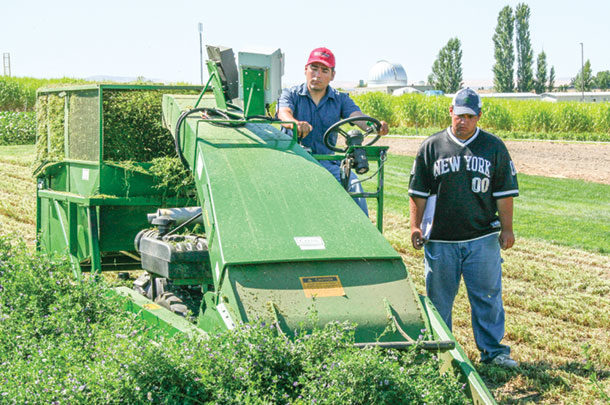The Washington Columbia Basin environment is uniquely qualified for producing high-quality hay and typically yields more than 10 tons per acre.
A potential future market for alfalfa that could develop is for biofuel use, using the stems. (The Department of Energy currently dismisses alfalfa as a potential biofuel feedstock due to its value as an animal feed.)
According to William Woodward, plant breeder and former dean for agriculture education, research and development at Columbia Basin College (CBC), alfalfa has some advantages over a grass crop when considered as a biofuel feedstock.
So what would it take to make alfalfa a viable biofuel? Reduced input costs. To that end, reducing the number of cuts and lengthening stand life would help. Since the traditional alfalfa varieties tend to lodge under pivot irrigation common to the Pacific Northwest, Woodward has been researching and developing non-lodging alfalfa varieties for several years.
Woodward conducted a cutting management experiment at Columbia Basin College to select varieties for dairy forage and biomass from 2010 to 2012. Ten alfalfa varieties (five traditional and five non-lodging) were tested under four cutting management systems (two, three, four and five cuts, respectively).
Forage yield and quality components – crude protein, acid detergent fiber, neutral detergent fiber, lignin, digestible dry matter and relative feed value – were recorded in the four cutting management systems.
Forage yield
Total yield in the five-cut system ranged from 11.1 tons per acre to 12.1 tons per acre. However, no significant differences were found among the varieties for total yield in 2011, 2012 or in combined yields for both years. Three non-lodging cultivars showed higher yield than all traditional varieties in the first cut, while alfalfa variety 54Q25 was lower-yielding than many of the varieties in the second cut.
Total yield in the four-cut system revealed no significant differences among the varieties. The three-cut system showed significant differences among the varieties for total yield and within cuts. All four non-lodging CBC varieties had significantly higher total yields than all of the traditional varieties.

In general, the non-lodging varieties had higher yields in each cut than the traditional varieties. In the two-cut system, all traditional varieties lodged severely and lost leaves due to leaf diseases. Significant differences were found among varieties for total yield. CBC varieties yielded higher than all of the traditional varieties.
Results show fewer cuts were more advantageous for the non-lodging cultivars. In all the four-cut systems, the CBC non-lodging variety yielded over 11 tons. The variety had about 67 percent higher yields than the best traditional variety in a two-cut system.
It is expected over time the more frequent cuttings will reduce stand life and health of the plants, causing a yield reduction. In the Columbia Basin, it is generally known four-cut systems will yield more than five-cut systems over time.
In general, CBC non-lodging forage variety yields were higher than that of traditional varieties.
Forage quality
Woodward and Steve Fransen (forage and extension agronomist at Washington State University) were interested in assessing the forage quality of traditional and conventional varieties. In general, they found traditional varieties had higher crude protein than the non-lodging entries within all cuts and when averaged across cuts in each management system.
Acid detergent fiber, digestible dry matter and relative feed value trended lower among the traditional entries within each cut and within the average of all cuts for each management system.
Generally, the non-lodging entries had higher neutral detergent fiber than the traditional entries among cuts and across the average of cuts in all four management systems. Crude protein ranged from 20.5 to 12.7 for non-lodging entries, and 21.2 to 14.3 for traditional entries for the five-cut management system and the two-cut system, respectively.
Although differences among entries for quality traits within the four-cut management systems were small, the trend was much larger when comparing values across cut management systems. Relative feed value fell sharply from 142.6 to 52.9 for the traditional entries in the five- and two-cut systems, respectively.
Lignin percentage increased across harvest systems, ranging from 6.2 to 9.6 for the five-cut and two-cut systems, respectively. Acid detergent fiber and neutral detergent fiber trended up across cutting management systems from five cuts to two. The range was 36.7 to 46.2, and 39.9 to 54.1 for acid detergent fiber and neutral detergent fiber, respectively. ![]()
PHOTO 1: Student interns Eliseo Navarro and Chris Lamm harvest alfalfa hay fields for research.
PHOTO 2: Non-lodging CBC varieties are straight and upright while the traditional varieties are dropping during this second cut of the four-cut system. Photos provided by Sandya Kesoju.
Sandya R. Kesoju, Ph.D. is the director for agriculture education, research and development with the Department of Agriculture at Columbia Basin College. Email Sandya R. Kesoju.










